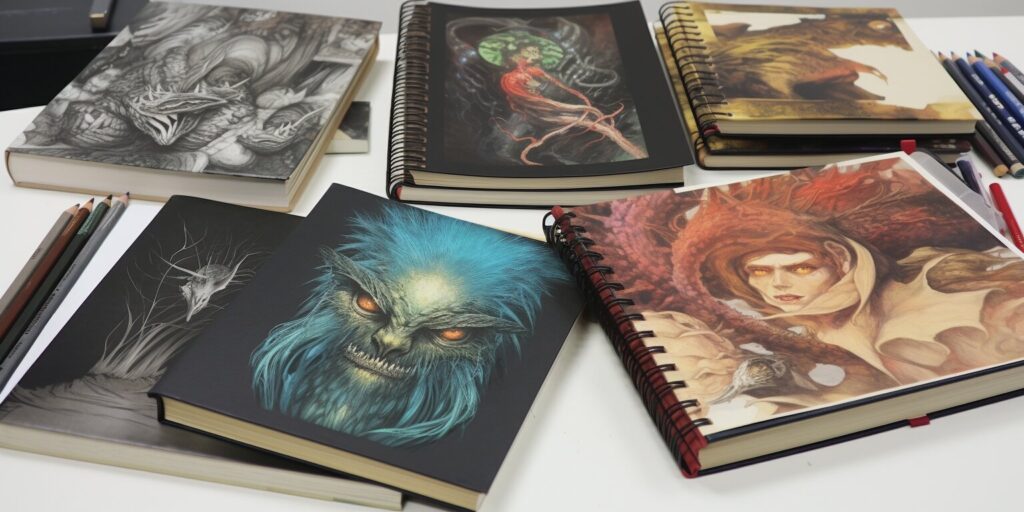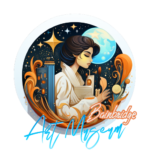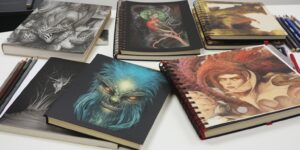Unleash Your Creativity with Premium Sketchbooks

Sketchbooks are an essential tool for artists of all levels. They provide a space to jot down ideas, experiment with different techniques, and keep track of progress. But not all sketchbooks are created equal.
High-quality sketchbooks are worth the investment, offering superior paper quality and durability. They allow artists to work with various mediums, from pencil sketches to watercolors, without worrying about smudging or bleeding.
Whether you’re a professional artist or just starting, using a premium sketchbook can make a significant difference in your work. In this article, we’ll explore the benefits of using high-quality sketchbooks and provide tips on finding the perfect one for your artistic needs.
So, let’s dive in and discover the world of sketchbooks!
Finding the Perfect Sketchbook for Artists
Choosing the right sketchbook can be overwhelming, but fear not! We’ve compiled a list of the best sketchbooks that cater to various drawing needs and styles.
Top Sketchbooks for Drawing
- Moleskine Art Sketchbook: With its thick, acid-free sketch-grade paper, this sketchbook is perfect for pencil, charcoal, and ink drawings.
- Strathmore 400 Series Sketchbook: Ideal for artists who use a variety of dry media, this sketchbook features a sturdy cover and high-quality paper.
- Canson Artist Series Universal Sketch Pad: This sketchbook is an excellent choice for those who enjoy drawing with markers and pens. Its heavyweight paper prevents bleed-through, making it perfect for double-sided sketches.
It’s important to keep in mind that the best sketchbook for you will depend on your drawing techniques, preferred mediums, and personal taste. Consider the paper quality, binding, and size when making your decision.
Sketchbooks for Different Drawing Techniques
Sketchbooks come in various sizes, bindings, and paper types, catering to different drawing techniques. Here are some recommendations for the most popular types of drawing:
- Sketchbooks for Pencil Drawings: Look for sketchbooks with smooth, medium-weight paper that can handle the pressure of a pencil. Softcover sketchbooks are also a great option for easy transport.
- Sketchbooks for Ink Drawings: Opt for sketchbooks with thicker paper to prevent bleed-through. Spiral binding makes it easier to flip pages and work on double-sided sketches.
- Sketchbooks for Charcoal Drawings: Thick, textured paper with a high tooth works best for charcoal drawings. Hardbound sketchbooks will keep your sketches safe and protect them from smudging.
Remember, the top sketchbooks for you will depend on your individual preferences. Experiment with different brands and styles to find the perfect match for your artistry.
Sketchbooks for Beginners: A Guide to Getting Started
If you’re new to the world of sketching and drawing, figuring out which sketchbook to get can be a daunting task. But don’t worry, we’ve got you covered. In this section, we’ll provide you with some valuable tips to help you choose the perfect sketchbook for your needs.
Consider Your Needs
Before purchasing a sketchbook, it’s essential to consider your needs. Do you plan to carry it around with you, or will it stay at home? What drawing techniques will you be using? Will you be using wet or dry media? By answering these questions, you’ll have a better idea of what kind of sketchbook will work best for you.
Paper Quality
Paper quality is one of the most important things to consider when choosing a sketchbook. As a beginner, it’s best to start with a sketchbook with 80-100 lb (or 130-160 gsm) paper. This will ensure that your paper won’t buckle or tear easily, allowing you to practice your drawing techniques with ease.
Size Matters
The size of your sketchbook can also affect your practice negatively or positively. If you plan to carry your sketchbook around or draw on the go, a smaller sketchbook may be more practical. However, if you’re looking to work on larger drawings or have more room for experimentation, a larger sketchbook may be more suitable.
Sketchbooks Designed for Beginners
Many sketchbook brands offer options specifically designed for beginners. These sketchbooks come in various sizes and paper types, making it easier for beginners to choose a suitable sketchbook. Some options even come with prompts or exercises to help you get started.
Get Started
Now that you have a better idea of what to look for when choosing a sketchbook, it’s time to get started. Remember to take your time, experiment, and, most importantly, have fun. Sketching is a great way to express yourself and unleash your inner creativity.
Sketchbooks for Professionals: Elevating Your Artistry.
If you’re a professional artist, you know that the sketchbook you use can make all the difference in the quality of your work. Choosing the right sketchbook can enhance your artistry and take your creativity to the next level. Here, we will explore some of the best sketchbook brands that professional artists swear by.
1. Moleskine Sketchbooks
Moleskine sketchbooks are a timeless classic that many professionals turn to when it comes to sketching. With high-quality paper and durable binding, these sketchbooks are perfect for artists on the go. The smooth texture of the paper allows for a wide range of drawing techniques, including ink, pencil, and charcoal.
2. Stillman & Birn Sketchbooks
Stillman & Birn is a favorite among professional artists for their versatile sketchbooks. With options for different paper weights, textures, and colors, these sketchbooks can handle any medium and style. The binding is sturdy, and the paper quality ensures that your artwork will last for years to come.
3. Canson Artist Series Sketchbooks
Canson is a trusted name in the art world, and their artist series sketchbooks are no exception. The paper quality is exceptional, with a smooth finish that’s perfect for both dry and wet media. The binding is strong and durable, making these sketchbooks perfect for frequent use.
4. Strathmore Series Sketchbooks
Strathmore is another well-respected brand in the art world, with their series of sketchbooks being a popular choice among professionals. The paper quality is top-notch, with a wide variety of textures and weights to choose from. The binding is sturdy, ensuring that your sketches remain safe and secure.
When it comes to sketchbooks for professionals, there are plenty of options to choose from. Whether you prefer a classic style or something more modern, there’s a sketchbook out there that will meet your needs. These sketchbook brands are just a few examples of the high-quality options available to you. Take some time to explore and find the one that suits your artistic vision best.
Exploring Different Types of Sketchbooks
Sketchbooks come in various styles, sizes, and materials, each catering to specific drawing techniques and preferences. Below are the different types of sketchbooks and their unique features:
Hardcover Sketchbooks
Hardcover sketchbooks are durable and provide excellent support for drawing on-the-go. They come in different sizes and paper types and are suitable for a range of artistic styles. The hardcovers also protect the pages from damage, ensuring the longevity of your artwork.
Spiral-Bound Sketchbooks
Spiral-bound sketchbooks are ideal for those who prefer working with a flat surface. They usually come in larger sizes and have a spiral binding that allows easy removal of pages. Artists who use charcoal or pastel prefer spiral-bound sketchbooks for their ease of use and flexibility.
Softcover Sketchbooks
Softcover sketchbooks are lightweight and compact, which makes them perfect for carrying around. They are ideal for artists who like to sketch on the go and prefer a sketchbook that can fit in their pocket or bag. Softcover sketchbooks also come in different paper types and sizes, making them suitable for a range of artistic styles.
Handmade Sketchbooks
Handmade sketchbooks are unique and highly customizable. Artists can choose the size, paper type, and cover design to suit their preferences and needs. Handmade sketchbooks are perfect for artists who want to create a personalized sketchbook that reflects their style and creativity.
Specialty Sketchbooks
Specialty sketchbooks cater to specific drawing techniques or styles, such as watercolor, ink, or manga. They come with specialized paper that is suitable for the particular medium and helps artists achieve the desired effects. Specialty sketchbooks are perfect for artists looking to explore new techniques and styles.
Choosing the right type of sketchbook is essential to bring your ideas to life. With the wide range of sketchbook options available, artists can select one that suits their unique needs and preferences. Consider the type of medium used, the size of the sketchbook, the binding, and the paper quality when making your choice.
Conclusion
Sketchbooks are an essential tool for any artist, whether you’re a beginner or professional. They allow us to capture our ideas, experiment with different drawing techniques, and document our progress. By investing in a premium sketchbook, you can unleash your creativity and enhance the quality of your artwork.
In this article, we have explored the various factors artists should consider when choosing a sketchbook. We discussed the benefits of using high-quality sketchbooks and provided recommendations for the best sketchbooks for drawing. We also provided insights for beginners looking to start their artistic journey and addressed professional artists’ specific needs.
Exploring Different Types of Sketchbooks
There are various types of sketchbooks available, catering to different artistic styles and preferences. Journal-style sketchbooks are ideal for artists who like to combine drawing with written notes. Spiral-bound sketchbooks are convenient for artists who prefer to work on a flat surface. Hardbound sketchbooks offer more durability and protection for your artwork.
The paper quality is another critical factor to consider when selecting a sketchbook. Sketchbooks with acid-free paper are ideal for preserving your artwork over time. Heavyweight paper is suitable for artists who like to use wet media such as watercolor or ink.
Ultimately, the type of sketchbook you choose will depend on your personal preferences and artistic needs. We encourage you to explore the wide range of options available and experiment with different types to find the perfect fit for you.
Thank you for reading this article, and we hope it has provided you with valuable insights into the world of sketchbooks. Remember, investing in a high-quality sketchbook is an investment in your creativity and artistic growth.
FAQ
What are the benefits of using premium sketchbooks?
Premium sketchbooks offer superior paper quality, providing a smooth surface for drawing and preventing ink bleed-through. They are also more durable, allowing artists to preserve their artwork for years to come.
How do I choose the best sketchbook for my needs?
When selecting a sketchbook, consider factors such as paper weight, size, and binding. Paper weight determines the thickness and texture of the paper, while size and binding depend on personal preferences and the intended use of the sketchbook.
Are there specific sketchbooks recommended for beginners?
Yes, there are sketchbooks specifically designed for beginners. Look for sketchbooks with instructional guides, prompts, or exercises to help you develop your skills and gain confidence in your artistic abilities.
Which sketchbook brands are popular among professional artists?
Some popular sketchbook brands among professionals include Moleskine, Strathmore, and Canson. These brands are known for their high-quality paper, durability, and ability to handle a wide range of drawing techniques.
What are the different types of sketchbooks available?
There are various types of sketchbooks available, including hardbound sketchbooks, spiral-bound sketchbooks, and sketchbooks with different types of paper, such as watercolor paper, toned paper, or mixed media paper. Each type caters to different artistic preferences and techniques.





